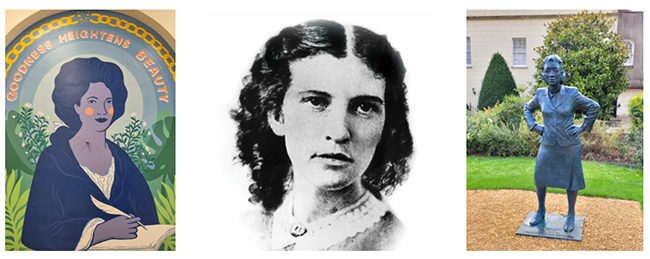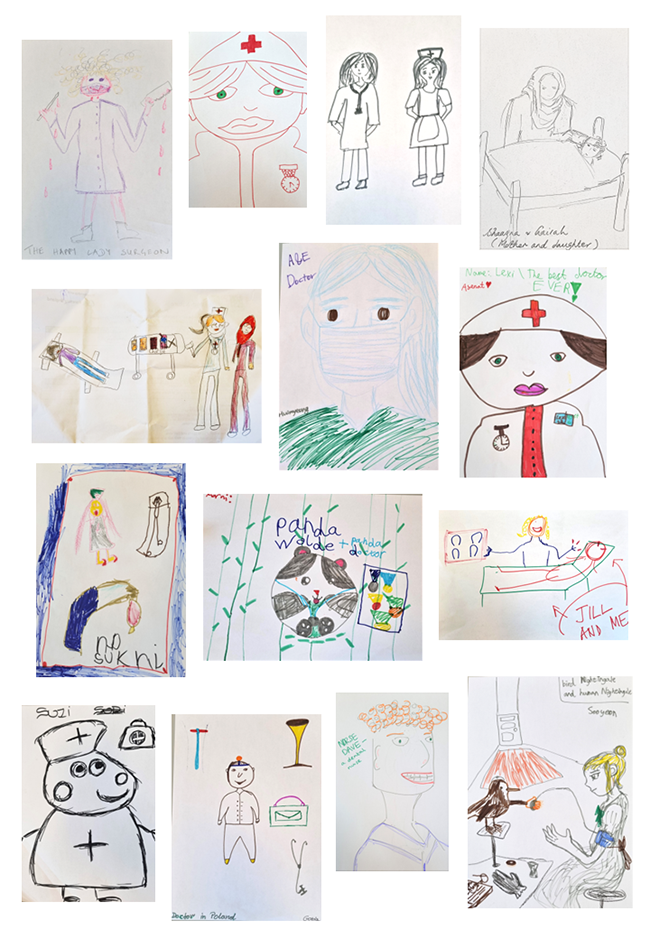We’ve been lucky to work with Bristol-based poet Rachel Bentham, Sheila Hannon of Show of Strength theatre company, and Ruth Myers of Local Learning CiC.
Combining their skills in writing, drama and workshop design, Rachel, Sheila and Ruth worked with Jo Stubbs at the EBI to develop a project that would celebrate the story of Elizabeth Blackwell – just as Blackwell’s 200th birthday came along in 2021.
We linked up with Hannah More Primary School and agreed to take the project along to an after-school club for parents and children. The focus was Pioneering Women – including Hannah More, an early campaigner for female education, Henrietta Lacks, whose statue now stands outside Royal Fort House, and Elizabeth Blackwell.

Image: from l-r mural of Hannah More at Hannah More Primary School, picture of a young Elizabeth Blackwell, and sculpture of Henrietta Lacks in Royal Fort Gardens, Bristol.
Who ever heard of Elizabeth Blackwell?
Delayed somewhat by the pandemic, in Spring 2022 we joined parents and children at Hannah More for three after school sessions. This included discussing our heroines and how people from the past are remembered. We went on to explore the roles of women in health, with the message from the room being that ‘it’s all about girl power!’.

Image: collage of drawings by Hannah More Primary school pupils and parents.
Alongside mentions of Mary Seacole and Florence Nightingale, Henrietta Lacks was also someone’s heroine. In Autumn 2021, a statue of Henrietta was installed outside Royal Fort House at the university. Created by Bristol-based artist Helen Wilson Roe, it was the first statue of a black woman made by a black woman to be permanently installed in the UK. Lack’s contribution to health has been enormous, through the Hela cell line she never knew she contributed to research. It was really interesting to discuss Henrietta’s story as a group and consider the reality of her never having given consent for her cells to be taken.
In September we hope to welcome the group to the university campus so that we can conclude our project with a closer look at Henrietta Lacks.
A sculpture and a living statue
With further funding from Heritage Schools, we went on to welcome two other school groups to Royal Fort House. Willow Park and SS Peter and Paul Primary both spent a morning at the University with year 5 and 6 classes. Both groups were surprised, after looking at the sculpture of Henrietta Lacks and discovering her story, to be joined by a second statue…a living statue.
The school groups had chance to interrogate Elizabeth Blackwell (now a cool 201 years old). Who are you? What do you do? Where were you born? They were also able to see and examine all the old instruments inside her medical bag and decide how and where she would stand if she became a real statue.
Having these ‘statues’ side-by-side gave the group chance to consider how the two women made vast but very different contributions to health. Blackwell, a white English woman, entered the world of medicine deliberately, with great struggle over many years. Lacks, a black American woman, died without knowing that her cells would be used for major research that continues to this day. A great opportunity to discuss consent, agency and opportunity.
Getting creative with a trio of firsts
Amongst other things, this project has been a chance to celebrate firsts: the first woman doctor, the first immortal cell line, and the first statue of a black woman made by a black woman to be permanently installed in the UK.
Inspired by this, we concluded our school sessions with artwork and poetry. Students used the conversations we’d had so far to inspire their own sculptures. Some of them drew these and some made plasticine models.

Image: pupils create plasticine models of women in health.
The sessions were then completed with a poem, written by Rachel Bentham and inspired by all the conversations we’d had so far in the project about the story and sculpture of Henrietta Lacks.
What’s next?
Outputs from this project have included poetry, drawings, models and lots of photos. We’re looking forward to sharing more of these over the summer and into the new school term.
For the Elizabeth Blackwell Institute, the project has been a great opportunity to celebrate the story of our namesake, collaborate with wonderful new partners, and work with some curious and thoughtful young people!
We hope these sessions will feed into continued exploration of how and why we remember Elizabeth Blackwell, and so many other women whose stories are not very well known.
